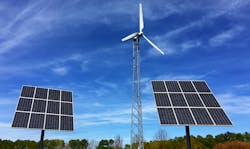IEEE Releases Guide for Distributed Energy Management Systems
On May 9, 2021 IEEE 2030.11 Guide for Distributed Energy Management Systems was approved as a new standard by the IEEE Standards Association Board.
This guide articulates functional specifications for Distributed Energy Resources (DER) management systems (DERMS). It includes guiding principles for the application and deployment of DERMS and DERMS control systems, addresses the basic functional requirements and proposes a set of core functions.
The purpose of DERMS is to aggregate and dispatch multiple DER, coordinate their operation in the distribution grid and optimize their output. With the increased deployment and penetration of Distributed Energy Resources (DER), aggregation of DER is an effective approach to integrate DER into the planning and operation of distribution systems and transmission systems.
The IEEE P2030.11 defines the DERMS interoperability requirements using IEEE Std 2030-2011 smart grid interoperability reference model (SGIRM) for all three interoperability levels: power, communications, and information technology. This mapping of aggregation and energy management is a major contribution to the revision of IEEE Std 2030-2011, which started April 2020.
Insights from IEEE P2030.11 DERMS working group have already been shared with interested parties in the industry for example NERC, ISOs and CIGRE C6.24 TSO/DSO – Operational Tools.
With FERC Order 2222, the functional specifications and architecture for the aggregation of DER in IEEE P2030.11 will be helpful to entities that are planning to participate in the electricity market for energy and ancillary services. The DERMS necessary functions and their implementation, as defined in the guide, set up the required system configuration for participation of aggregated DER in the DER enabled markets as directed by FERC. These functions can be further detailed to serve FERC Order 2222 requirements as needed.
Although the FERC Order 2222 does not specifically refer to DERMS as an entity participating the service market and aggregation offers, it provides an effective and efficient way to manage a large number of DER. In addition to defining a functional specifications for enabling grid services, the DERMS interoperability requirements in IEEE P2030.11 can be expanded to cover existing and new market mechanisms that enable DER market participation as laid out in the FERC Order.
From a technical and engineering point of view, IEEE P2030.11 will facilitate the realization of FERC’s goals for DER participation in markets, and the DER ability to offer grid services to the transmission and distribution networks.
The guide is intended to provide a common language and define core functionalities for a DERMS to a wide range of stakeholders, including vendors, utilities, energy service providers, developers, codes and standards organizations, regulators and legislators and governing bodies.
Although publishing by the IEEE SA will take 6 – 8 weeks, the standard can be adopted and referenced by regulators, utilities and aggregators. ISOs can refer to it for implementation of FERC 2222.
For more information, please contact any officer of the IEEE 2030.11 Working Group:
Geza Joos, Chair – Email: [email protected]
Bob Cummings, Vice Chair – Email: [email protected]
Tony Johnson, Vice Chair – Email: [email protected]
James T Reilly, Secretary - Email: [email protected]
